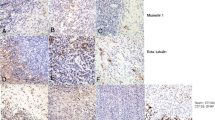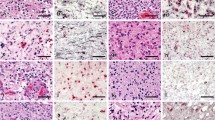Abstract
The SOX group E transcription factors play an integral role in the specification and differentiation of astrocytes and oligodendrocytes. We have examined the pattern of expression for SOX9 and SOX10 in primary brain tumors by immunohistochemistry. Pediatric and adult high grade tumors display strong nuclear staining for both SOX9 and SOX10 (astrocytic, oligodendroglial and primitive neuroectodermal tumors). In comparison pediatric pilocytic astrocytoma express much less SOX9 and SOX10. Reactive astrogliosis is characterized by an increase of SOX9 only.
Similar content being viewed by others
References
Wegner M (1999) From head to toes: the multiple facets of Sox proteins. Nucleic Acids Res 27(6):1409–1420
Stolt CC, Lommes P, Sock E, Chaboissier MC, Schedl A, Wegner M (2003) The Sox9 transcription factor determines glial fate choice in the developing spinal cord. Genes Dev 17(13):1677–1689
Stolt CC, Schmitt S, Lommes P, Sock E, Wegner M (2005) Impact of transcription factor Sox8 on oligodendrocyte specification in the mouse embryonic spinal cord. Dev Biol 281(2):309–317
Stolt CC, Rehberg S, Ader M, Lommes P, Riethmacher D, Schachner M et al (2002) Terminal differentiation of myelin-forming oligodendrocytes depends on the transcription factor Sox10. Genes Dev 16(2):165–170
Schuurmans C, Guillemot F (2002) Molecular mechanisms underlying cell fate specification in the developing telencephalon. Curr Opin Neurobiol 12(1):26–34
Sauvageot CM, Stiles CD (2002) Molecular mechanisms controlling cortical gliogenesis. Curr Opin Neurobiol 12(3):244–249
Kordes U, Cheng YC, Scotting PJ (2005) Sox group E gene expression distinguishes different types and maturational stages of glial cells in developing chick and mouse. Brain Res Dev Brain Res 157(2):209–213
Hemmati HD, Nakano I, Lazareff JA, Masterman-Smith M, Geschwind DH, Bronner-Fraser M et al (2003) Cancerous stem cells can arise from pediatric brain tumors. Proc Natl Acad Sci USA 100(25):15178–15183
Kleihues P, Cavenee WK (2000) Pathology and genetics of tumours of the nervous system. Lyon, International Agency for Research on Cancer
Maka M, Stolt CC, Wegner M (2005) Identification of Sox8 as a modifier gene in a mouse model of Hirschsprung disease reveals underlying molecular defect. Dev Biol 277(1):155–169
Gershon TR, Oppenheimer O, Chin SS, Gerald WL (2005) Temporally regulated neural crest transcription factors distinguish neuroectodermal tumors of varying malignancy and differentiation. Neoplasia 7(6):575–584
Mandell JW, Gocan NC, Vandenberg SR (2001) Mechanical trauma induces rapid astroglial activation of ERK/MAP kinase: evidence for a paracrine signal. Glia 34(4):283–295
Mischel PS, Shai R, Shi T, Horvath S, Lu KV, Choe G et al (2003) Identification of molecular subtypes of glioblastoma by gene expression profiling. Oncogene 22(15):2361–2373
Johansson FK, Goransson H, Westermark B (2005) Expression analysis of genes involved in brain tumor progression driven by retroviral insertional mutagenesis in mice. Oncogene 24(24):3896–3905
Pomeroy SL, Tamayo P, Gaasenbeek M, Sturla LM, Angelo M, McLaughlin ME et al (2002) Prediction of central nervous system embryonal tumour outcome based on gene expression. Nature 415(6870):436–442
Cheng YC, Lee CJ, Badge RM, Orme AT, Scotting PJ (2001) Sox8 gene expression identifies immature glial cells in developing cerebellum and cerebellar tumours. Brain Res Mol Brain Res 92(1–2):193–200
Janss AJ, Yachnis AT, Silber JH, Trojanowski JQ, Lee VM, Sutton LN et al (1996) Glial differentiation predicts poor clinical outcome in primitive neuroectodermal brain tumors. Ann Neurol 39(4):481–489
Bannykh S, Stolt C, Kim J, Perry A, Wegner M (2006) Oligodendroglial-specific Transcriptional Factor SOX10 is Ubiquitously Expressed in Human Gliomas. J Neurooncol 76(2):115–127
Acknowledgement
Antibodies against SOX9 and SOX10 were kindly provided by Prof. Wegner, Erlangen. This work was supported by the Fördergemeinschaft Kinder-Krebs-Zentrum Hamburg e.V.
Author information
Authors and Affiliations
Corresponding author
Additional information
Note added in proof Bannykh et al. [18] also describe expression of SOX10 in human gliomas




